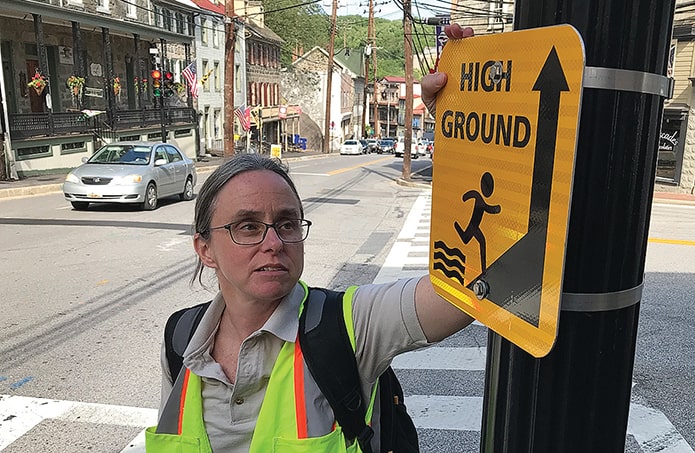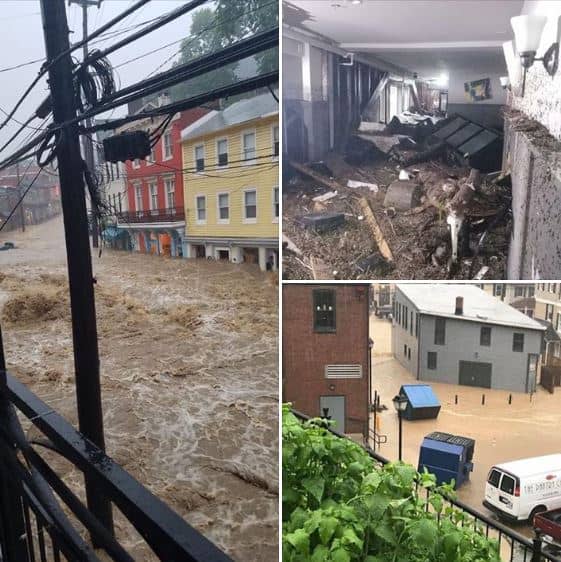Ravaged twice in two years by killer flash floods, Ellicott City, MD, is embarking on an ambitious and costly race against time to shield the historic mill town from severe storms that appear to be striking with increasing frequency.

Howard County Executive Calvin Ball unveiled a flood mitigation plan in May that aims to keep Ellicott City “safe and sound.” It proposes boring a tunnel to siphon floodwaters away from the quaint shops and restaurants lining Main Street and building or expanding stormwater retention ponds and culverts farther up the watershed.
Ball’s plan would also demolish four of the historic buildings on lower Main and modify up to six more.
“When you look at the reality of it, there are some buildings that just have to come down in order to ensure the highest level of public safety possible,” Ball said in an interview.
The floods that devastated old Ellicott City on July 30, 2016, and on May 27, 2018, were generated by “1,000-year storms,” with rains so intense that meteorologists consider them exceptionally rare and put the probability of their occurring in any year at 1 in 1,000.
However, extreme rainfall events have become much more frequent across the Northeast since the 1950s, a trend scientists say is likely to keep happening as the global climate continues to change in the coming decades.
Ellicott City has been flood-prone since its founding as a grain mill community in 1772. It was built in a steep, rocky valley where four streams come together before flowing into the Patapsco River. Some of the buildings actually sit atop culverted stream channels.
Over the years, Main Street has been inundated dozens of times, but there have been three major floods in the last seven years, including Tropical Storm Lee in 2011. In the past, flooding came from the Patapsco rising out of its banks, but the two most recent floods were “top-down,” meaning that rain falling in the 11-square mile Tiber-Hudson watershed burst from the channels of the streams that would normally carry it to the larger river.
The first flood claimed two lives, damaged 90 businesses, displaced nearly 100 residents and put hundreds out of work. But the community cleaned up, repaired and returned.
The 2018 flood killed one person and washed out many of the same businesses and residents. The county has repaired the damage to public infrastructure, including one road closed for months after it washed out. But a number of businesses and residents have opted not to come back.
Flood mitigation projects planned after the 2016 storm were still mostly on the drawing board when last year’s flood hit. Ball’s predecessor as county executive, Allan Kittleman, responded with a proposal to buy and take down 10 buildings on lower Main Street to turn that flood-prone area into a waterfront park.
Ball, a County Council member who defeated Kittleman in last year’s election, opposed that plan, saying he thought a better balance could be struck between safety and retaining historic structures. His plan has a target completion date of 2024, the same as Kittleman’s, but it would cost significantly more; estimates range from $113.5 million to $140.5 million, compared with $85 million for the previous plan.

“I wanted to ensure that we had a plan that kept more water off of Main Street and away from the west end [of town],” Ball said. “And I recognize that in this changing climate, where we have more frequent and intense storms, the nation and the world are watching how we deal with these issues. I want us to be an example for resiliency, and how we respect and preserve the nature and character of a city while also putting public safety first.”
The county budgeted about $17 million in each of the last two years to work on projects intended to ease flooding in Ellicott City. Where the rest will come from is an open question.
“It’s an aggressive plan,” said James Irvin, the county’s public works director. “If everything falls into place, it’s doable.” But, he said, much depends on raising enough funds to pay for the rest. The county is hoping for significant help from the state to relieve the burden on local taxpayers.
Even if fully funded and carried out, the plan doesn’t claim to eliminate the threat of flooding, just reduce the depth and velocity of the rushing water. Once all the work is completed, officials say floodwaters that measured 5.5 feet deep at the foot of Main Street during the 2016 storm should be no deeper than 3 feet. And in less severe storms, they say, the water should be less than a foot deep.
But some worry the county seems fixated on plans designed in response to the 2016 flood when storms can vary. Streamflows and floodwaters were actually higher in the 2018 flood, according to the U.S. Geological Survey. And the surge was nearly twice as great down one tributary, New Cut Branch, which comes in on the opposite side of Main Street from the planned flood tunnel.
“If the storm concentrates in a different area, the tunnel wouldn’t do any good,” said Lori Lilly, executive director of the nonprofit Howard EcoWorks, which is working to get area homeowners to replace grass lawns with more rain-absorbing vegetation.
“Every storm is different,” said Mark DeLuca, deputy county public works director. The county’s plan is focused, he explained, on reducing flooding where it’s the worst, at the base of Main Street. Even so, the runoff retention projects in the works should ease flooding everywhere, officials say.
Historic preservation advocates, who had opposed Kittleman’s plan, praise the new blueprint’s proposal to retain more of the existing structures.
“In a situation like this, there’s no perfect outcome,” said Nicholas Redding, executive director of Preservation Maryland. But he called Ball’s plan a “win” for historic preservation, while also improving safety.
Redding said he sees Ellicott City as a test case for how historic communities can survive floods and other weather-related calamities in an increasingly volatile climate. But he said it’s also a teachable moment for coming to terms with the costs of improvident development.
Many residents are convinced the flooding has worsened because of continued development of the heights above town. Roughly two-thirds of the land in the 11-square-mile watershed is developed, and more than 20% is covered by hard surfaces such as pavement and rooftops.
Much of that development occurred decades ago, before there were any stormwater management requirements. The county has tightened its regulations in more recent years, but residents contend the county was still too willing to waive the rules.

“Ellicott City is not the only place in the state that’s suffering from these mistakes,” Redding said. But the consequences are most acutely felt there, because the terrain makes the community especially vulnerable to flash flooding.
After the 2018 flood, the County Council imposed a building moratorium in the watershed and then extended it until the end of October to consider whether stormwater requirements should be tightened still more to deal with flash flood conditions.
The county has asked the U.S. Army Corps of Engineers and other flood experts to review its plan, which they hope will build public confidence that the proposed mitigation projects will work as designed. Meanwhile, county officials are forging ahead, striking deals for eight of the 10 properties it wants to acquire.
One business that came back now finds itself forced to get out. The Phoenix Emporium, a pub that’s been a fixture at the foot of Main Street for four decades, occupies one of the buildings the county intends to knock down.
“Of course, I’d love to be able to stay in this location, but that’s not possible,” pub owner Mark Hemmis said. He added that he recognizes the county had to do something after the back-to-back disasters. “I’m no expert,” he said, “but changing climates and developmental issues all need to be addressed.”
While the brick-and-mortar projects take time, county officials say they are doing what they can now to enhance safety. They’ve instituted a more aggressive regimen for clearing debris out of stream channels after heavy rains. Tree limbs, furniture and even rocks washed downstream can worsen flooding by constricting or even blocking culverts.
The county also has installed a public-alert system that emits beeping tones if officials believe a flash flood is imminent or likely. Signs also are being posted pointing people toward high ground.
Beth Woodruff, who lives in the west end of town, said she and her neighbors aren’t relying solely on the county’s alarm. They formed their own flood-warning network, sending out text alerts and sounding air horns outside if they see rising water.
In both floods, the rampaging water gouged sedan-sized craters in Woodruff’s front yard, washed out her driveway and nearly invaded her home — missing by only an inch last year. Since 2016, she’s kept a “go” bag with essentials to grab if she and her family need to flee another deluge. Last year, she said, she and her son and dog escaped to higher ground just 20 minutes before the road became impassable. Her home sits at a spot where the Hudson Branch, no more than a concrete chute at that point, flows through a culvert under Main Street. Woodruff calls it a “poorly designed funnel” that causes the stream to jump out of its channel and rush down the road.
The county informed her in May that it wanted to buy her house — one of 10 additional properties it wants to acquire this year in the west end and Valley Meade, another flood-prone neighborhood even farther out. Plans are to use her land to install an overflow pond when the stream threatens to surge out of its chute.
“I told them that because I realized something has to be done with that culvert that we would be willing to go if it was necessary,” Woodruff said. She’d like to find a new home in the same school district for her son’s sake, but it likely won’t be in the same neighborhood.
“Ellicott City is where my heart is,” she said, “I care about these people, I care about the town.” But the homes there in less vulnerable areas are too expensive, she explained, “and the places I could afford are too dangerous.”
Even so, Woodruff said, she’s relieved that the county is taking action.
“I’m glad to see that a lot of the major pinch points and major issues are being addressed,” she said. But she added that she’s worried about whether five years is soon enough to get the work done.
“No matter what administration is in power,” she said, “they’re fighting against time. … We never know when the next flood is coming. It really could be tomorrow. How quickly real change can be made is of the utmost importance.”




